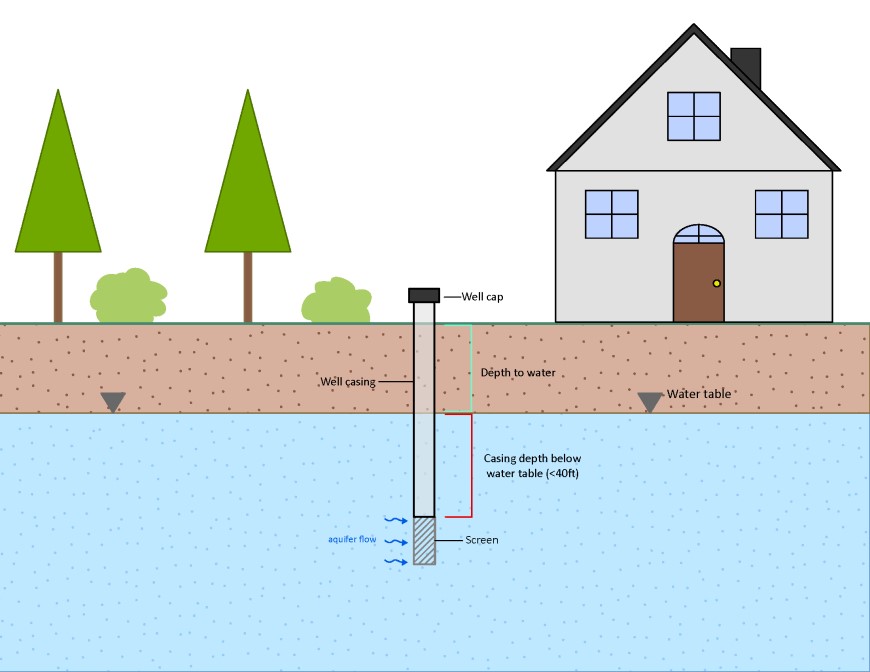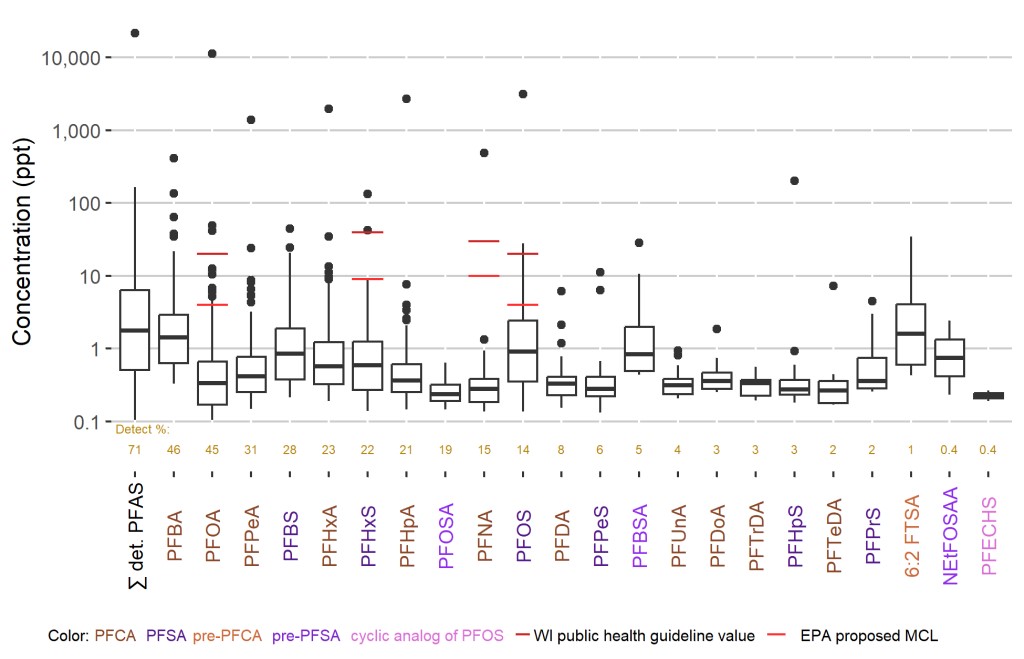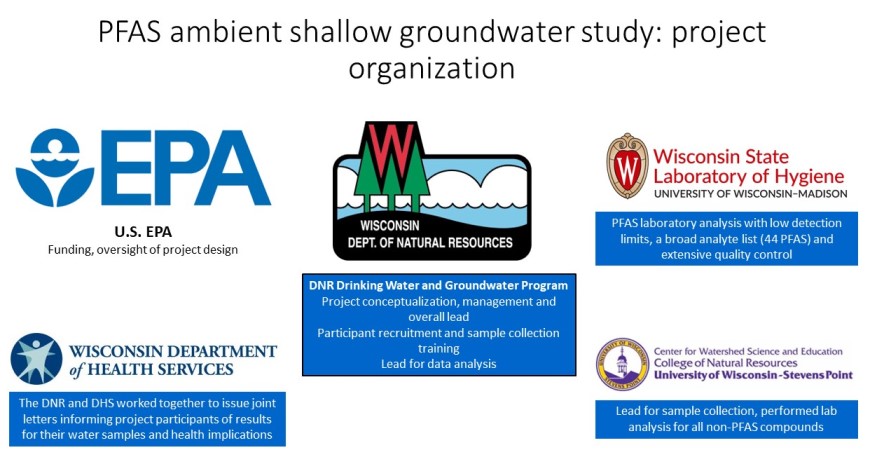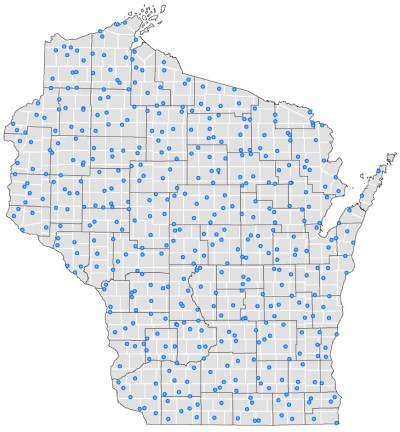PFAS Ambient Shallow Groundwater Study
This study was conducted to evaluate the occurrence of perfluoroalkyl and polyfluoroalkyl substances (PFAS) in Wisconsin shallow groundwater. Over 95% of Wisconsin’s communities and about 70% of Wisconsin residents rely on groundwater for their drinking water supply. PFAS have been detected in groundwater in some areas of the state, but overall prevalence in groundwater prior to this study was unknown. This research project was funded by the U.S. Environmental Protection Agency (EPA).
This webpage provides an overview and key findings about the PFAS ambient shallow groundwater study. The study was published Nov. 2, 2023 in the scientific journal Environmental Science & Technology. The full published version of the study can be found here.
The focus of this study was to provide an overview of current conditions in shallow groundwater. The shallow groundwater provides an “early warning” to assess threats to the overall state of the groundwater resource used by most Wisconsinites for their drinking water. While PFAS were detected in 71% of the study samples, only 1% were above a Wisconsin public health value, and 4% were above an EPA proposed Maximum Contaminant Level (MCL). The results of this study are not representative of the conditions in all private wells in Wisconsin (there are over 800,000 with varying depths from which water is drawn).
- Study at a glance
-
In the summer and fall of 2022, the DNR’s Drinking Water and Groundwater Program partnered with the University of Wisconsin-Stevens Point (UWSP) and the Wisconsin State Laboratory of Hygiene (WSLH) to collect 450 water samples from residences with shallow private wells across Wisconsin and test them for 44 PFAS compounds as well as other organic and inorganic compounds. This study represents the first systematic sampling of shallow groundwater located away from major municipalities and/or PFAS investigation and cleanup sites. Since approximately 70% of Wisconsin’s population depends on groundwater for their drinking water supply, it is important to understand the prevalence of PFAS in groundwater to assess current and future needs for protecting this valuable resource.
What is meant by "shallow groundwater" for this study?
Only wells with casing no deeper than 40 feet below the water table were selected for this study. Casing depth is how far down the well casing extends into the ground. The depth to water is the depth from the ground surface to the water table. See diagram below.
What is known about PFAS levels in deeper groundwater?
In general, the shallower the groundwater, the “younger” it is. The “age” of the groundwater refers to how long ago the water entered the subsurface. Since PFAS started being used around the 1950s, younger groundwater equates to higher risk. Deeper groundwater can still be affected, however, depending on specific hydrogeologic conditions.
- What are the results & how common are PFAS in Wisconsin?
-
The WSLH tested for 44 PFAS compounds and 22 were detected in one or more project samples. PFAS were detected in 71% of samples, but only a low percentage of those samples were above a WI health guideline value or EPA proposed MCL. The two most often detected PFAS were perfluorobutanoic acid (PFBA) and perfluorooctanoic acid (PFOA) (46% and 45%, respectively). PFAS were commonly detected in all land types in WI. PFAS were found most often in developed areas (89%) followed by forested (70%), grassland (69%), and agricultural areas (65%). However, the three highest PFOA concentration levels were found in agricultural areas.
Other tests, such as human medications and artificial sweeteners, were used as indicators of PFAS in human waste. Liquid effluent from septic systems could be a reason why PFAS were detected in some private well water samples.
How to read the graph (boxplot): From left to right, PFAS compounds are shown from highest to lowest detection frequency, starting with PFBA being detected in 46% of samples to PFECHS being detected in 0.4% of samples. Each box shows the median concentration detected (center line) and each box extends from the 25th to the 75th percentile concentration. Lines extending from each box are levels detected outside of those percentiles. The dots are samples with concentrations detected outside of those percentiles.
Key points:
- PFAS were detected in 71% of samples, with low percentages of samples being above either a WI health guideline value (1%) or EPA proposed MCL (4%).
- Of the 44 PFAS compounds this method is able to detect, 22 were found in samples collected in this study.
- Eighteen PFAS compounds have human health-based drinking water recommendations as determined by the Wisconsin Department of Health Services (DHS). Not all PFAS compounds currently have enough information to set human-health drinking water standards. For a list of these compounds and the standards, visit the DHS PFAS webpage.
The Wisconsin recommended groundwater standards also serve as WI Public Health Guideline Values for PFAS. The EPA recently proposed MCLs for six PFAS in drinking water. For more on the EPA’s MCL proposals, please visit the EPA’s PFAS webpage.
The table below compares PFAS levels found in the study to WI public health guideline values and EPA proposed MCLs.
Wisconsin Health Levels For PFOA & PFOS: NR 140 Cycle 10, June 2019; PFHxS & PFNA: NR 140 Cycle 11, November 2020 Type of PFAS Number of samples above EPA proposed health based level EPA proposed health based level (parts per trillion (ppt)) Percentage of samples above EPA proposed health based level Number of samples above WI health guideline value WI public health guideline (parts per trillion (ppt)) Percentage of samples above WI guideline value PFOA 13 4 ppt 3.0% 3 20 ppt 0.6% PFOS 11 4 ppt 2.0% 2 20 ppt 0.4% PFHxS 2 9 ppt 0.4% 2 40 ppt 0.4% PFNA 1 10 ppt 0.2% 1 30 ppt 0.2% - Where are PFAS found in Wisconsin?
-
Key points:
- PFAS were detected in 71% of the shallow private wells in the study
- 89% of wells in developed areas
- 65% of wells in agricultural areas
- 70% of wells in forested areas
- 69% of wells in grassland areas
- The levels (or amount) of PFAS in developed areas were significantly different from forested, grassland and agricultural land uses
- Developed areas had a higher median (median = the level at which half of the results were above and half below) concentration (or amount) of PFAS than forested or agricultural areas.
- Agricultural areas had the highest overall concentrations of PFAS.
- Forested areas had the lowest median and lowest overall levels of PFAS.
- The locations in Wisconsin with four of the five highest detected PFAS levels were in areas with either agriculture or grassland as the main land use.
- One sample location had PFOA detected at more than 100 times greater than any other sample in the study. The DNR has undertaken additional sampling at this location.
A 500-meter radius was used to determine the land use category for each well (based on Wiscland2).
- PFAS were detected in 71% of the shallow private wells in the study
- Non-PFAS (other water quality parameters)
-
The UWSP Water and Environmental Analysis Lab analyzed organic and inorganic compounds in the 450 water samples.
Non-PFAS parameters were analyzed in all of the samples. Artificial sweeteners and pharmaceuticals commonly consumed by humans were used to determine the presence of human waste and herbicide compounds as indicators of agricultural impacts.
The table below lists non-PFAS parameters that were found in the study above a WI Public Health Guideline Value.
Non-PFAS parameter Wisconsin public health or welfare value Number of samples above WI public health guideline value Percentage of project samples above WI public health guideline value Nitrate plus nitrite (as nitrogen) 10 parts per million 36 8% Arsenic 10 parts per million 9 2% Sulfate 250 parts per million (83 parts per million S, if all S is sulfate) 9 2% Manganese 300 parts per billion 24 5% Chloride 250 parts per million 2 <1% - How are parameters related?
-
Key Points:
- PFAS are often found when other PFAS are also present and/or when artificial sweeteners (acesulfame and sucralose) and chloride and nitrate are also present
- PFAS are less often found along with herbicide metabolites alachlor ESA and metolachlor ESA, and agricultural land use
Study findings indicate that human waste sources, septic systems in particular, are likely contributors to PFAS in shallow groundwater. Another finding is that most agriculture does not appear to be a major source of PFAS.
For correlations between all parameters, please see the published article.
- Who was involved in conducting the study?
-
- Wisconsin Department of Natural Resources - Drinking Water & Groundwater Program
- U.S. EPA
- Wisconsin State Laboratory of Hygiene - UW-Madison
- Wisconsin Department of Health Services
- Center for Watershed Science & Education - College of Natural Resources - UW-Stevens Point
- How were the study participants chosen?
Wisconsin divided by 450 equal area cells. To make sampling representative, Wisconsin was divided into a grid of 450 equal area cells, each about 125 square miles. The participants were selected randomly within each grid cell. The 450 equal cells are outlined in white in the map below. For more information on known PFAS sites in Wisconsin, please visit the PFAS Investigation and Cleanup webpage.
- Frequently asked questions
-
Where do PFAS come from?
Per- and polyfluoroalkyl substances, or PFAS, are a group of human-made chemicals that have been used for decades to create foaming agents and are also used in consumer products to repel oil, stains, grease and water. Such products include some firefighting foams, stain-resistant carpets and fabrics, non-stick cookware, fast food packaging, clothing, personal care products and cosmetics. There are many different potential sources of PFAS in the environment. For more information, see the DNR’s PFAS page and ITRC webpage.
How are we exposed to PFAS?
Exposure to PFAS can occur through food, household dust and product use, in addition to drinking water. For more information, see the DHS website.
What is being done about PFAS in the environment in Wisconsin?
In order to address PFAS in Wisconsin waters, the Wisconsin PFAS Action Council (WisPAC) was created. In their PFAS Action Plan, this group recommended that Wisconsin specific PFAS research be conducted to increase understanding of PFAS in the environment. Recommended research includes sampling various environmental media, such as soil, sediment, surface water and groundwater to gain a better understanding of the occurrence of PFAS in the environment and to potentially detect previously unidentified PFAS source areas so that they can be evaluated.
Why do some PFAS show up and some not?
This depends mainly on two factors: the source or sources of PFAS locally and how readily the particular PFAS travel through the subsurface. Some PFAS travel more easily through soil and groundwater than others, for example PFOA is more “mobile” in the subsurface than PFOS. See the ITRC website for more information.
Why are PFAS important?
PFAS have been found in numerous environmental media and have negative effects to humans and the environment, even at low concentrations. More information on PFAS can be found on the ITRC website.
I have a private well. What does this mean for me?
Fewer than 1% of study samples had PFAS above WI recommended health levels. If you are considering having your water tested for PFAS, the DNR also recommends first having your private well water tested for other common groundwater contaminants, in particular nitrate, bacteria and arsenic.
While this study gives some initial indications of PFAS levels relative to different land uses, the only way to know PFAS levels is to get your water tested.
Based on this study it appears that it is more common to find PFAS in areas with relatively high housing density, compared to agricultural areas, but at levels that are often below public health guideline values. While detections in agricultural areas are somewhat less common than in developed ones (65% detection frequency vs. 89%), the three highest levels of PFOA in this study were found in agricultural areas. Forested areas showed the lowest overall PFAS concentrations, of the four land use types.
What if I have water from my well tested and high levels of PFAS are found?
If PFAS are found in samples of water from your well above WI recommended groundwater standards, you may be eligible for an American Rescue Plan Act of 2021 (ARPA) Well Compensation Grant.
Where can I get my water tested?
The DNR recommends that private well owners test annually for nitrate and bacteria, and testing at least once for arsenic and for any other substance you are concerned about. If you are a private well owner and you would like to have your water tested for PFAS, the DNR recommends using a DNR certified lab. Costs for PFAS testing are typically in the range of $300 - $500. The DNR generally recommends asking the laboratory for testing using EPA Method 537.1, which is a PFAS Drinking Water Method. If you call a DNR certified laboratory, the lab can give you further instructions and guidance.
I’m connected to a public water system. What does that mean for my water quality?
If you get your water from a public water system, you can visit the DNR’s Drinking Water System Portal for information on contaminants that have been tested under the EPA’s Safe Drinking Water Act or the state’s NR 809, Safe Drinking Water, Wis. Adm. Code, which includes the WI MCL of 70 ng/L combined PFOA and PFOS.
Additional links
- Journal Article: Prevalence and Source Tracing of PFAS in Shallow Groundwater Used for Drinking Water in Wisconsin, USA
DNR
- PFAS Investigation & Cleanup
- PFAS Contamination in the Town of Stella
- Land cover data - Wiscland2
- PFAS
- Wisconsin PFAS Action Council (WisPAC)
- Wisconsin PFAS Action Plan
- Drinking Water Tests for Private Wells
- American Rescue Plan Act of 2021 (ARPA) Well Compensation Grant
- Test Your Private Well Water Annually
- PFAS lab analysis in Wisconsin
- Drinking water
- Look up drinking water data
- Drinking Water System Portal
- GIS Open Data Portal - view or download PFAS study data
DHS
EPA
ITRC




